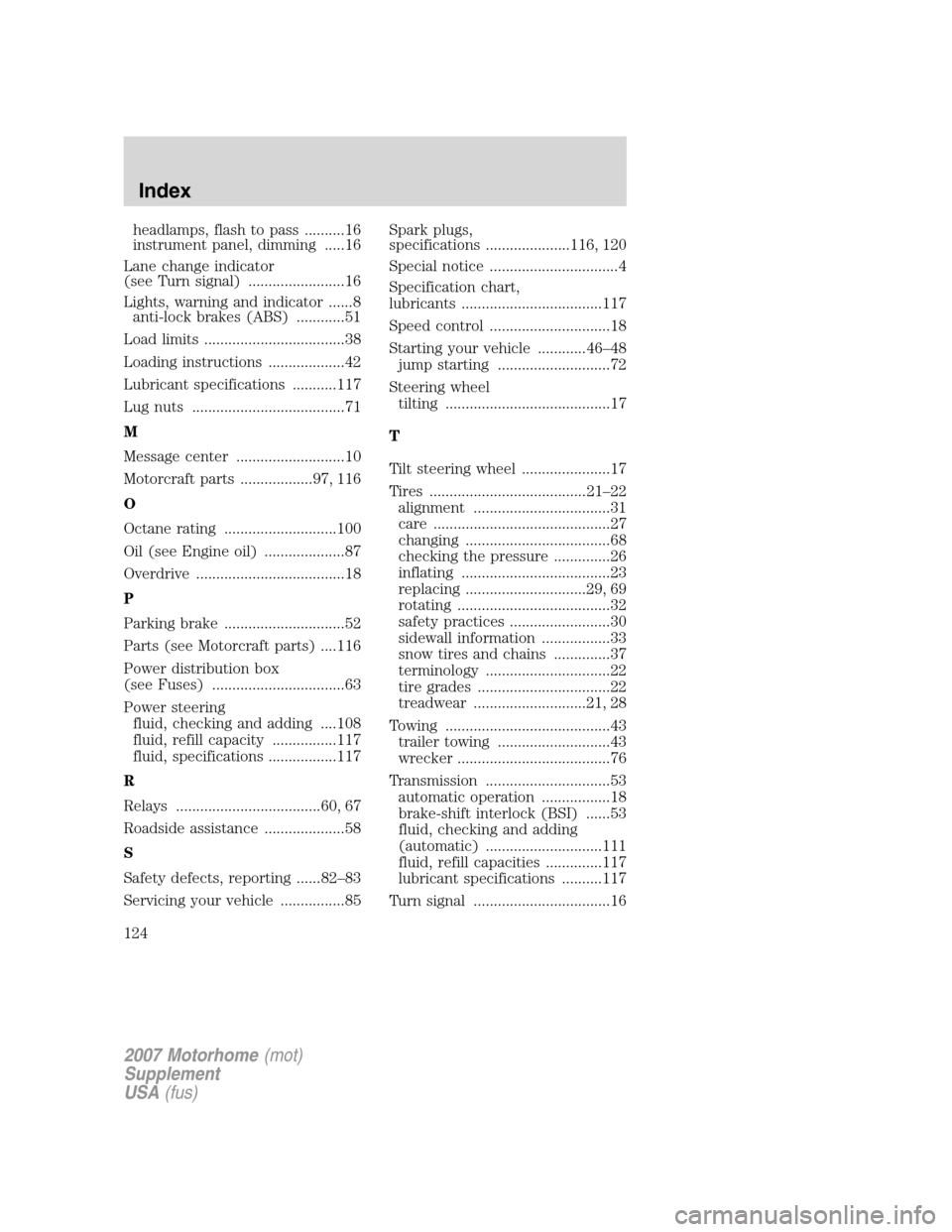Page 7 of 128
Vehicle Symbol Glossary
Power Windows
Front/Rear
Power Window Lockout
Child Safety Door
Lock/UnlockInterior Luggage
Compartment Release
Symbol
Panic AlarmEngine Oil
Engine CoolantEngine Coolant
Temperature
Do Not Open When HotBattery
Avoid Smoking, Flames,
or SparksBattery Acid
Explosive GasFan Warning
Power Steering FluidMaintain Correct Fluid
LevelMAX
MIN
Emission SystemEngine Air Filter
Passenger Compartment
Air FilterJack
Check Fuel CapLow Tire Pressure
Warning
2007 Motorhome(mot)
Supplement
USA(fus)
Introduction
7
Page 11 of 128

Low fuel:Displays when the fuel
level in the fuel tank is at or near
empty (refer to Fuel gaugein this
chapter).
Check gauge: Displays when any of
the following conditions has
occurred:
• The engine coolant temperature
is high.
• The engine oil pressure is low.
• The fuel gauge is at or near empty.
Language
The language options are English and French. The feature works as
follows:
1. If present language is English,
press and hold the SELECT/RESET
button for 15 seconds or greater to
convert the language selection to
French. The word �FRENCH �will be
displayed for 4 seconds as a confirmation that language has been
changed.
2. If present language is French,
press and hold the SELECT/RESET
button for 15 seconds or greater to
convert the language selection to
English. The word �ENGLISH �will
be displayed for 4 seconds as a confirmation that language has been
changed.
Parking brake ON warning chime: Sounds when the parking brake is set,
the engine is running and the vehicle is driven more than 3 mph (5 km/h).
MINI message center activation chime: Sounds when some warning
messages appear in the message center display for the first time.
Fail safe cooling warning chime: Sounds when CHECK GAUGES is
displayed in the message center and the coolant gage pointer has moved
to hot. Three one second chimes are level 1 warnings. Five one second
chimes are level 2 warnings.
2007 Motorhome (mot)
Supplement
USA (fus)
Instrument Cluster
11
Page 13 of 128

Trip odometer:Registers the miles
(kilometers) of individual journeys.
Press and release the
SELECT/RESET button on the
cluster to toggle between odometer and trip odometer display. To reset,
press and hold for less than 2 seconds.
Engine hour meter:Registers the
accumulated time the engine has
been running.
Press the SELECT/RESET button
until the engine hours display.
Tachometer:Indicates the engine
speed in revolutions per minute.
Driving with your tachometer
pointer continuously at the top of
the scale may damage the engine.
Engine oil pressure gauge:
Indicates engine oil pressure. The
needle should stay in the normal
operating range (between “L” and
“H”). If the needle falls below the
normal range, stop the vehicle, turn
off the engine and check the engine
oil level. Add oil if needed. If the oil
level is correct, have your vehicle checked by your authorized dealer.
Fuel gauge:Indicates
approximately how much fuel is left
in the fuel tank (when the ignition
is in the ON position). The fuel
gauge may vary slightly when the
vehicle is in motion or on a grade.
Refer toFilling the tankin the
Maintenance and Specifications
chapter for more information.
2007 Motorhome(mot)
Supplement
USA(fus)
Instrument Cluster
13
Page 104 of 128

•You may want to turn off the speed control in hilly terrain if
unnecessary shifting between the top gears occurs. Unnecessary
shifting of this type could result in reduced fuel economy.
•Warming up a vehicle on cold mornings is not required and may
reduce fuel economy.
•Resting your foot on the brake pedal while driving may reduce fuel
economy.
•Combine errands and minimize stop-and-go driving.
Maintenance
•Keep tires properly inflated and use only recommended size.
•Operating a vehicle with the wheels out of alignment will reduce fuel
economy.
•Use recommended engine oil. Refer toMaintenance product
specifications and capacitiesin this chapter.
•Perform all regularly scheduled maintenance items. Follow the
recommended maintenance schedule and owner maintenance checks
found inscheduled maintenance information.
Conditions
•Heavily loading a vehicle or towing a trailer may reduce fuel economy
at any speed.
•Carrying unnecessary weight may reduce fuel economy (approximately
1 mpg [0.4 km/L] is lost for every 400 lb [180 kg] of weight carried).
•Adding certain accessories to your vehicle (for example bug
deflectors, rollbars/light bars, running boards, ski/luggage racks) may
reduce fuel economy.
•Using fuel blended with alcohol may lower fuel economy.
•Fuel economy may decrease with lower temperatures during the first
8–10 miles (12–16 km) of driving.
•Driving on flat terrain offers improved fuel economy as compared to
driving on hilly terrain.
•Transmissions give their best fuel economy when operated in the top
cruise gear and with steady pressure on the gas pedal.
•Close windows for high speed driving.
2007 Motorhome(mot)
Supplement
USA(fus)
Maintenance and Specifications
104
Page 124 of 128

headlamps, flash to pass ..........16
instrument panel, dimming .....16
Lane change indicator
(see Turn signal) ........................16
Lights, warning and indicator ......8 anti-lock brakes (ABS) ............51
Load limits ...................................38
Loading instructions ...................42
Lubricant specifications ...........117
Lug nuts ......................................71
M
Message center ...........................10
Motorcraft parts ..................97, 116
O
Octane rating ............................100
Oil (see Engine oil) ....................87
Overdrive .....................................18
P
Parking brake ..............................52
Parts (see Motorcraft parts) ....116
Power distribution box
(see Fuses) .................................63
Power steering fluid, checking and adding ....108
fluid, refill capacity ................117
fluid, specifications .................117
R
Relays ....................................60, 67
Roadside assistance ....................58
S
Safety defects, reporting ......82–83
Servicing your vehicle ................85 Spark plugs,
specifications .....................116, 120
Special notice ................................4
Specification chart,
lubricants ...................................117
Speed control ..............................18
Starting your vehicle ............46–48
jump starting ............................72
Steering wheel tilting .........................................17
T
Tilt steering wheel ......................17
Tires .......................................21–22 alignment ..................................31
care ............................................27
changing ....................................68
checking the pressure ..............26
inflating .....................................23
replacing ..............................29, 69
rotating ......................................32
safety practices .........................30
sidewall information .................33
snow tires and chains ..............37
terminology ...............................22
tire grades .................................22
treadwear ............................21, 28
Towing .........................................43 trailer towing ............................43
wrecker ......................................76
Transmission ...............................53 automatic operation .................18
brake-shift interlock (BSI) ......53
fluid, checking and adding
(automatic) .............................111
fluid, refill capacities ..............117
lubricant specifications ..........117
Turn signal ..................................16
2007 Motorhome (mot)
Supplement
USA (fus)
Index
124